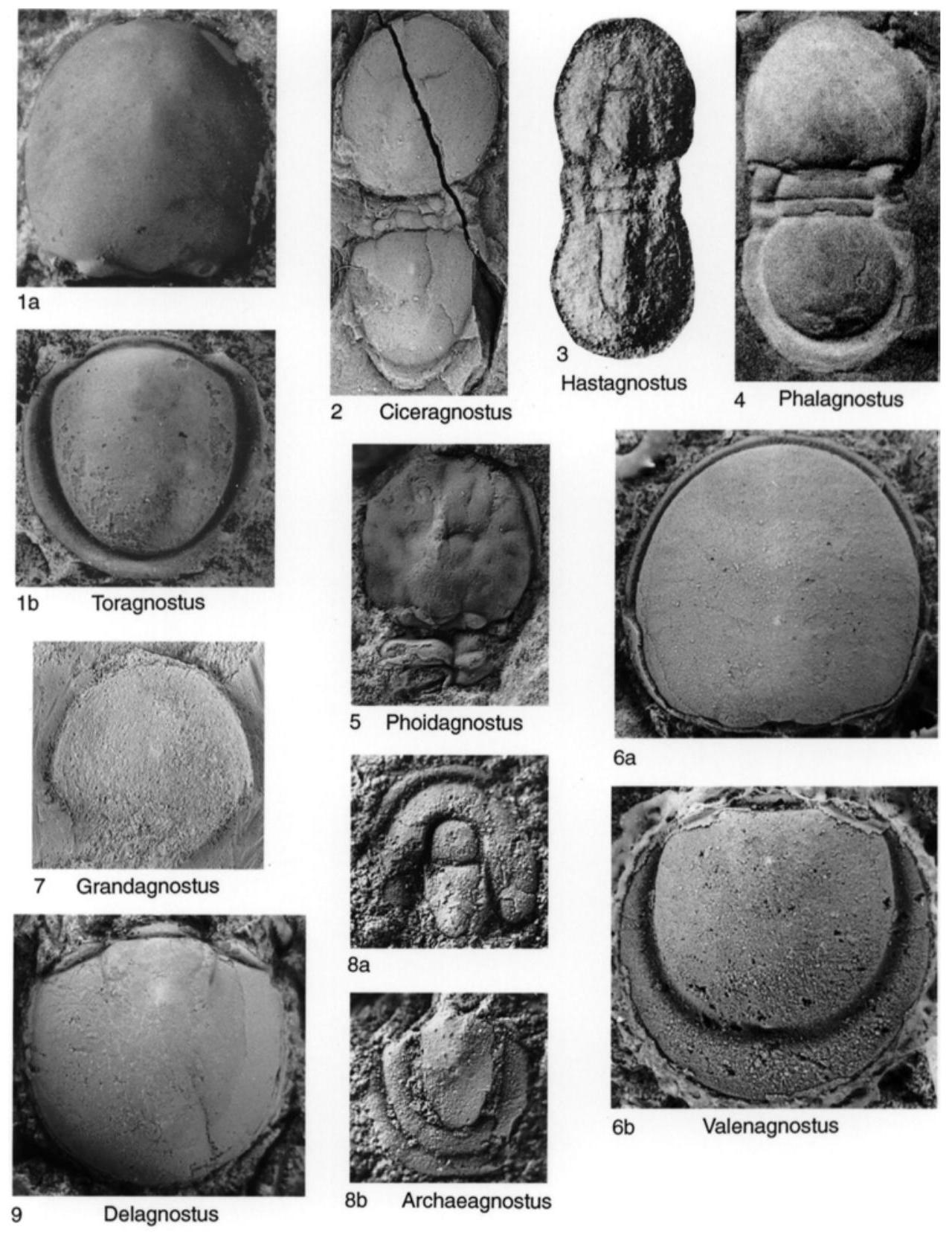Welcome to the Treatise on Invertebrate Paleontology!
Please enter a genera name to retrieve more information.

Phalagnostus
Classification
Phylum:
Arthropoda
Class:
Trilobita
Order:
Agnostida
Superfamily:
Agnostoidea
Family:
Agnostoidea - Uncertain Family
Formal Genus Name and Reference:
Phalagnostus Howell, 1955, p. 925, Battus nudus Beyrich, 1845, p. 46, neotype (Barrande, 1852, pl. 49, fig. 6, SD ŠNAJDR, 1958, p. 78), ČC 229, No. 1017, NMP, Prague
Type Species:
Battus nudus Beyrich, 1845, p. 46, OD, neotype (Barrande, 1852, pl. 49, fig. 6, SD ŠNAJDR, 1958, p. 78), ČC 229, No. 1017, NMP, Prague
Images
(Click to enlarge in a new window)
Fig . 239,4. *P. nudus (B EYRICH); Middle Cambrian (E. pusillus Zone), Czech Republic (Tyrovice, Bohemia); neotype, exoskeleton, NM CC 229, No. 1017, ×5 (Snajdr, 1958, pl. 5, fig. 3).
Synonyms
Phalacromina
Geographic Distribution
Sweden, P. punctuosus Zone; Denmark, P. tessini Zone; Wales, England, H. parvifrons Zone; France, Paradoxides beds; Czech Republic, Eccaparadoxides pusillus Zone; Russia (Bennett Island, Yakutia), Canada (Newfoundland), P. davidis Zone; ?Canada (Northwest Territories), Cedaria minor and Olenaspella regularis to Proceratopyge rectispinata Zones; ?USA (Vermont).
Age Range
Beginning Stage in Treatise Usage:
Middle Cambrian
Beginning International Stage:
Cambrian Stage 4
Fraction Up In Beginning Stage:
40
Beginning Date:
512.3
Ending Stage in Treatise Usage:
Middle Cambrian
Ending International Stage:
Guzhangian
Fraction Up In Ending Stage:
50
Ending Date:
498.75
Description
Almost totally effaced. Only glabellar culmination and small basal lobes weakly defined, otherwise cephalon totally effaced. Pygidial axis circular or ovate, defined by deep axial furrows, pygidial acrolobe undivided postaxially, forming posteriorly elongate pseudoborder, possibly with ventrally directed true border, anterolateral border furrow crossing pseudoborder and separating almost horizontal articulating facets, vestigial, elongate axial node present.
References
Museum or Author Information
Classification
Phylum:
Arthropoda
Class:
Trilobita
Order:
Agnostida
Superfamily:
Agnostoidea
Family:
Agnostoidea - Uncertain Family
Formal Genus Name and Reference:
Phalagnostus Howell, 1955, p. 925, Battus nudus Beyrich, 1845, p. 46, neotype (Barrande, 1852, pl. 49, fig. 6, SD ŠNAJDR, 1958, p. 78), ČC 229, No. 1017, NMP, Prague
Type Species:
Battus nudus Beyrich, 1845, p. 46, OD, neotype (Barrande, 1852, pl. 49, fig. 6, SD ŠNAJDR, 1958, p. 78), ČC 229, No. 1017, NMP, Prague
Images
(Click to enlarge in a new window)
Fig . 239,4. *P. nudus (B EYRICH); Middle Cambrian (E. pusillus Zone), Czech Republic (Tyrovice, Bohemia); neotype, exoskeleton, NM CC 229, No. 1017, ×5 (Snajdr, 1958, pl. 5, fig. 3).
Synonyms
Phalacromina
Geographic Distribution
Sweden, P. punctuosus Zone; Denmark, P. tessini Zone; Wales, England, H. parvifrons Zone; France, Paradoxides beds; Czech Republic, Eccaparadoxides pusillus Zone; Russia (Bennett Island, Yakutia), Canada (Newfoundland), P. davidis Zone; ?Canada (Northwest Territories), Cedaria minor and Olenaspella regularis to Proceratopyge rectispinata Zones; ?USA (Vermont).
Age Range
Beginning Stage in Treatise Usage:
Middle Cambrian
Beginning International Stage:
Cambrian Stage 4
Fraction Up In Beginning Stage:
40
Beginning Date:
512.3
Ending Stage in Treatise Usage:
Middle Cambrian
Ending International Stage:
Guzhangian
Fraction Up In Ending Stage:
50
Ending Date:
498.75
Description
Almost totally effaced. Only glabellar culmination and small basal lobes weakly defined, otherwise cephalon totally effaced. Pygidial axis circular or ovate, defined by deep axial furrows, pygidial acrolobe undivided postaxially, forming posteriorly elongate pseudoborder, possibly with ventrally directed true border, anterolateral border furrow crossing pseudoborder and separating almost horizontal articulating facets, vestigial, elongate axial node present.
